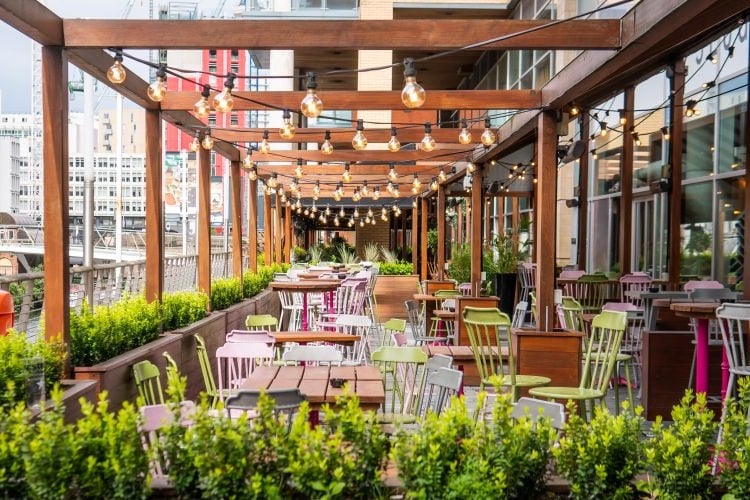New York City is still learning what many great cities around the world already know: life doesn’t stop when the weather turns cold. In Copenhagen, Vienna, Paris, and Seoul, outdoor dining continues through winter—beneath transparent canopies, along pedestrian corridors, and beside radiant heaters that turn streets into gathering places. These cities treat the street not merely as infrastructure but as a civic commons—a shared, comfortable third space that strengthens community. New York, by contrast, remains caught in a false choice between order and vitality, dismantling one of its most humanizing post-pandemic achievements.
Recently, City Councilmember Lincoln Restler reintroduced legislation to allow year-round roadway dining. It’s a welcome correction. When the city forced restaurants to shutter their outdoor setups each November, it didn’t just hurt business; it dimmed public life itself. The pandemic-era “sheds” were imperfect—some clumsy, others intrusive—but they proved something essential: New Yorkers want to live publicly again. The appetite for midwinter dinner al fresco never vanished.
Cities abroad have shown how to do this well. In Amsterdam and Oslo, modular and transparent enclosures extend restaurants seamlessly onto sidewalks. These structures are windproof, easily removed, and well-lit and serve as a bridge between private hospitality and public life. They invite warmth and conversation into spaces that would otherwise sit dark and unused. When people gather outdoors, even in cold months, they generate civic energy and real community; the quiet affirmation that the city belongs to its residents, not to cars, bureaucrats, or fear of inconvenience. Vibrancy, after all, is not a seasonal luxury but a sign of a functioning urban democracy.
New York’s earlier experiment revealed the same potential. As I argued when the sheds came down and Covid-19 restrictions lifted, they were more than a pandemic improvisation—they were a spontaneous act of civic renewal. The sheds gave ordinary people reason to linger, meet, and rediscover the pleasures of proximity. In a city that so often prizes speed and separation, they offered a different rhythm: One of presence, light, and community. Done well, these structures restore the public to public life.
The case for bringing them back isn’t just cultural; it’s economic and civic. Thousands of restaurants survived 2020–22 because outdoor dining kept them solvent. Today, fewer than 2,000 establishments are approved for the city’s seasonal program, less than half the pre-reform number. Year-round permission, with streamlined permitting and clear safety rules, would restore a crucial revenue stream for small businesses still burdened by high rents, inflation, climbing food costs, and staffing shortages.
The social benefits are equally clear. Outdoor dining encourages interaction across lines of class, neighborhood, and background. It draws people onto the street, boosts foot traffic for nearby stores, and fosters precisely the kind of conviviality that dense urban life depends on. When lights flicker in the cold and conversation carries across tables, trust and belonging quietly rebuild themselves. The simple act of dining outdoors transforms the city from a collection of private silos into a shared civic theater.
The question is not whether to revive winter dining, but how. Restler’s proposal includes sensible requirements on sanitation and snow removal. Those must be paired with a few additional principles. The city should pre-approve a small set of modular, transparent designs that meet code and aesthetic standards; offer low-interest loans or small grants to help independent operators afford construction; and create a single digital permitting process to eliminate bureaucratic purgatory. Above all, these enclosures should be treated as temporary extensions of the public realm, not private property.
Critics will argue that the old sheds cluttered sidewalks or harbored pests. Those complaints were valid but are generally solvable through design and proper management. The right response is not to retreat from outdoor life but to refine it: cleaner, safer, more curated for safety. The city that prides itself on creativity should be able to manage snow clearance and waste pickup without reverting to empty streets.
There is something deeply civic about a city that refuses to hibernate. Outdoor dining affirms that public life matters; that the street belongs not only to cars or commerce but to people. The sheds, in their best form, embody that spirit. They remind us that New York’s greatest asset is not its skyline or its subways, but its capacity for shared experience.
If we allow that spirit to wither each winter, we lose something essential. If we nurture it—with thoughtful design, sensible policy, and a touch of warmth—we gain a city that feels alive in every season.
Let New York dine through winter. The cold is no excuse for emptiness. As William H. Whyte observed, “What attracts people most, it would appear, is other people.” It’s time to give them the spaces and the freedom to meet, linger, and belong.

